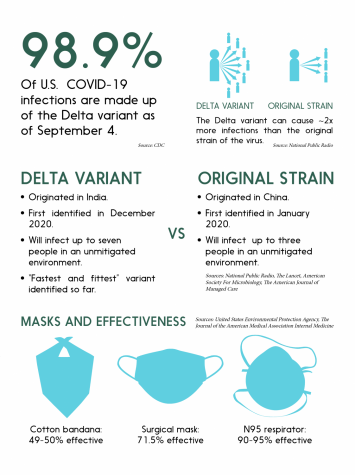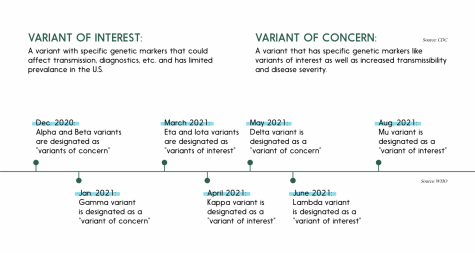What’s the deal with Delta?
The Delta variant of COVID-19 has recently been making headlines, but what differentiates it from other strains of the virus? Read on to learn what sets Delta apart.
The COVID-19 Delta variant has been in the news recently.
After a year of isolation, the general public was ready to get back to a version of pre-pandemic life. With widespread availability of vaccines and quickly decreasing case counts, the summer of 2021 was something to look forward to. However, as the summer progressed, the number of COVID-19 cases began to rise. Doctors and scientists credit this increase to the Delta variant, a new strain of COVID-19 that has made its way to the U.S.
The Delta variant was first identified in India in late 2020, but wasn’t discovered in the U.S. until March. Delta had shown up in all 50 states by July 1 due to its swift transmission rate.
“The major thing that makes it stand out is that it’s at least twice as transmissible as the earlier strains,” said Dr. Eli Perencevich, a professor of epidemiology at the University of Iowa. “Instead of one person infecting two or three other people, now, with the Delta variant, one person can infect six or eight people.”
These high transmission rates are because the Delta variant grows faster and more abundantly in people’s respiratory tracts compared to previous strains of COVID-19, especially in unvaccinated people. According to Jamie Mears, West High’s school nurse, vaccinated people can still get COVID-19 and have symptoms, but the illness will not be as serious.

“[If vaccinated people wearing masks get COVID-19] hopefully they will just get less symptomatic and not have to be hospitalized, just experience cold symptoms, headaches, fatigue, sore throat is kind of what we’re seeing with the positive cases. I haven’t been told anybody’s been hospitalized or anything,” Mears said. “On the other hand, I feel like we have seen in the community more hospitalizations and they tend to be getting pneumonia or sicker without the vaccination or if they have other illnesses.”
According to the CDC, the group of greatest risk regarding the Delta variant is unvaccinated people because they have a higher chance of getting infected, having harsher symptoms and spreading it to others. Therefore, according to Perencevich, the best way to protect against the virus is to get vaccinated.
“A mask is only one layer. If all we know is that the majority are wearing masks, the more that we’re masking the better, but it’s really not enough to be safe in an indoor space with just masks,” Perencevich said. “Ideally, we would want the majority vaccinated or everyone vaccinated, certainly everyone in high school should be vaccinated at this point. Then, if you’re vaccinated and wearing a mask, it’s a really safe environment.”
The primary reason to continue to wear masks is for other people in the community, especially those who are immunocompromised. Research shows that the risk of transmission of airborne particles containing the virus is decreased by as much as 75% when wearing a mask. In times like these, the quickest way to return back to normalcy is to wear masks and get vaccinated.
“If you’re vaccinated and wearing a great mask, and you’re young, you’re really not at risk for bad outcomes unless you have an underlying condition. I don’t want to discount that,” Perencevich said. “There are people who are immunocompromised, and it’s a different ballgame for them. That’s why I wear a mask. I’m vaccinated, I’m healthy – I wear a mask because I don’t want to transmit the virus to someone who’s immunocompromised and the vaccine doesn’t work for them.”
On September 20, Pfizer announced that the COVID-19 vaccine was safe for children ages 5-11, but it is still waiting to be approved by the FDA and CDC. Approval will be an important step in preventing the spread of Delta for this population.
“Many of us have brothers and sisters or kids who are under 12 years old in elementary school, and they don’t have access to the vaccine,” Perencevich said. “Since it’s a new virus, even though they’re not likely to die if they get the virus, many are ending up in the hospital. It’s a new virus so we don’t know what the long-term effects of the infections are.”
Regarding masks, there’s also work to be done at a local level.
Gov. Kim Reynolds signed a law banning face mask mandates in school districts May 20. The state of Iowa is one of five states currently being investigated by the U.S. Education Department over mask mandate bans. However, a southern Iowa district court temporarily overturned the ban, and the ICCSD has reinstated its mask mandate.

Locally, the Delta variant has affected students at West in several ways. The risk associated with it has caused some students to make a last-minute decision to stay online this school year, including Emily Beltran ’22.
“I want to be cautious, because I’m with my mom, and I don’t want to get sick, because she has no form of vaccines … I also don’t want to spread it to anybody else, especially since Delta is more contagious than any other variant out there,” Beltran said. “I was quite saddened by it, actually, because it’s my senior year, and I can’t spend it at school. It was a tough decision to make. I thought to myself, ‘This is one [year] I have to sacrifice.’”
Your donation will support the student journalists of West High School. Your contribution will allow us to purchase Scholarship Yearbooks, newsroom equipment and cover our annual website hosting costs.

(she/they) Kailey Gee is a senior at West High, and this is their third year on staff. She's working as the Co-Print-Editor-in-Chief with Hanah Kitamoto....

(she/her) Jane Lam is a senior at West High. This is her third year on staff reporting for the print publication. As an assistant copy editor, she loves...

(she/they) Sachiko is a senior at West, and this will be their 3rd year on staff. She is a design editor and photographer for the print publication. In...



